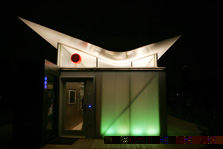

Virginia Polytechnic Institute and State University's energy-efficient, solar-powered house won the Solar Decathlon 2005 Architecture and Dwelling contests.
(Credit: Stefano Paltera, Solar Decathlon)
Solar Decathlon 2005
Think Like a Decathlete: A Summary of Strategies
Solar Decathlon is an extremely valuable educational opportunity for a wide variety of people. However, it is also a very intriguing competition. Formulating and executing a sound strategy is critically important in the competition. The following is a small sample of questions teams typically ask themselves when developing their strategies:
We want a large PV array so that we complete our tasks and drive the car many miles, but can we integrate it into the building design so that the architecture jury still finds it appealing?
Should our heating and cooling system be designed for a hot and sunny week or a cold and cloudy week? Should we try to find a compromise between these two extremes?
Should we optimize the performance of our house for Washington, D.C., or its final destination?
School is in session during the competition, so everyone on the team can't be in D.C. for three full weeks. When and for how long should our specialists be in D.C. to maximize our chances for success?
It is 2 p.m. and our car has a dead battery. Should we charge it one more time so that we can accumulate a few more miles today or should we keep the house batteries fully charged since we know that the weather forecast is calling for consecutive cold and cloudy days that will require heat.
Dimmable fluorescent lighting products are available on the marketplace, but are still relatively expensive. Should we use them in our house to demonstrate the "next generation" of dimmable lighting technology, or should we go with more conventional lamps to demonstrate exceptional lighting design at a low cost?
There are many, many more questions like these that teams have asked and answered for themselves during the past two years. During house tours, ask the teams about their overall strategy or strategy for a specific aspect of the competition that you find particularly interesting. You will find that there are many (in this case, 18) different solutions to the design challenges and many ways to "play the game."
